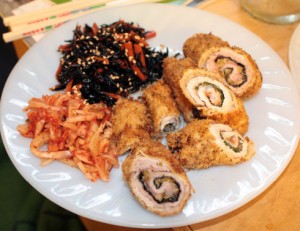A friend gave me this book, Washoku: Recipes from the Japanese Home Kitchen by Elizabeth Andoh. As a foodie, he happend to have two copies and really loves this book. More than just a cookbook with recipes, it bridges the gap between connecting culture with cooking. Having grown up in a Korean household and eating Korean foods every day, a strong connection to food as culture is very important to me.
Ms. Andoh is not native Japanese, rather she moved to Japan in the 60s and since then has lived in and mastered the cuisine of Japan. So Washoku is more than just a chef’s novel adventure story to another country. The first third of the book explains all the ingredients in traditional Japanese cooking—from explanations of different kinds of tofu and seaweed to terminology and specific techniques.
The book then moves into the various types of food categories: rice, noodles, vegetables, meats, tofu and eggs. Each recipe is a lesson into itself, with cross-referenced page numbers to ingredients you would need to prepare that dish. While it can be a little overwhelming. For example, to make Hito Kuchi Tonkatsu (pork cutlets, pictured) you need to make or have some Leek Miso, whose recipe is on another page. As well, it being a Japanese cookbook, some of the ingredients are hard to find in standard grocery stores (barley miso anyone?) but it is worth the trip to Sunrise or Mitsuwa*.
But it’s worth it.
With the pork cutlets, I also made the soy-braised Hijiki No Nimono (Hijiki and Carrots) and they were a delicious surprise. Hijiki is a dark fine seaweed and the recipe has them cooked with soy sauce and sugar to yield a sweet seaweed dish. Of course, being Korean, I couldn’t resist serving it with some kimchee my mother made. (See Picture)
The curry is also spot on for asian curries. A mild curry, it has a distinct flavor that differs from traditional South Asian curries. My mom used to make us Korean curry using B&H curry that comes liquid in a pouch, but making it from scratch is so much better.
I’m excited to make more recipes from this book. It’s a welcome change from the “american” food we eat and even though it’s Japanese, it inspires me to eat in the way I was raised.
*Note: Mitsuwa is this awesome Japanese superstore in Edgewater, NJ. There is a shuttle bus that will take you from Port Authority to the store for $3 each way. They sell all types of Japanese/asian foods (not organic) like real wasabi and lotus root. There is also a large food court where you can get all varieties of udon, soba, rice dishes and desserts. If they had wi-fi, I would hang out there all day!

